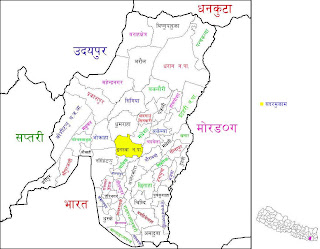सुनसरी जिल्ला नेपालको पूर्वाञ्चल विकास क्षेत्रको कोशी अञ्चलमा रहेको अत्याधिक जनघनत्व भएको जिल्ला हो। यस जिल्लाको दक्षिणमा भारत, पूर्वमा मोरङ जिल्ला, उत्तरमा इलाम तथा धनकुटा जिल्ला र पश्चिममा सप्तकोशी नदीले सप्तरी जिल्लासित छुट्याएको छ। इनरूवा यस जिल्लाको सदरमुकाम हो । १२५७ बर्ग कि.मी. क्षेत्रफलमा फैलिएको यस जिल्लामा करिव ७ लाख मानिसको बसोबास रहेको छ। अधिकांश भाग तराईमा पर्ने सुनसरी जिल्लाबासीको मुख्य पेशा कृषि हो। धान, गहुँ, दलहन, तेलहन पछि उखु, जूट र सुर्ती पनि यस जिल्लामा उत्पादन हुन्छ। सुनसरी जिल्ला दक्षिणमा समुद्र सतहदेखि १५२ मिटर र उत्तरमा ९१४ मिटर उचाईमा रहेको छ। जिल्लामा मुख्यतयाः राई, लिम्बू, बाहुन, क्षेत्री, थारू, सतार आदि जनजातिको बसोबास पाइन्छ।
यस जिल्लाको नामाकरण भरौल गाविस क्षेत्रको चारकोसे झाडीबाट उत्पत्ति भएको सुनसरी नदीको नामबाट भएको हो। यो नदी भरौल, बक्लौरी, सिंगिया, भोक्राहा, नरिसंह, जल्पापुर हुँदै भारततर्फ बगेको छ। सुनसरी जिल्ला महाभारत पर्वत श्रृङ्खला, चारकोसे जङ्गल र तराईका उर्वर भागहरू मिलेर बनेकोछ। यस जिल्लाको भौगोलिक वनावटलाई उत्तरको पहाडी प्रदेश, मध्यभागको भावर प्रदेश र दक्षिणको समथर भुमि गरी मुख्य तीन भागमा विभाजन गर्न सकिन्छ।
यस जिल्लाका प्रमुख नदी तथा ताल तलैयाहरूमा सप्तकोशी, कोकाहा, सुनसरी, बुढी, सेउती, सर्दु, खेतीखोला, टेंग्रा, पकलीखोला आदि पर्दछन्। भने नेपालका केहि प्रसिद्ध धार्मिक स्थलहरु पनि यसै जिल्लामा अवस्थित छन् । जस्तै बराहक्षेत्र, दन्तकाली, पिण्डेश्वर, बुढासुब्बा, शिवजट्टा, रामधुनी, विष्णुपादुका चतारा धाम आदी।
यस जिल्लाको नामाकरण भरौल गाविस क्षेत्रको चारकोसे झाडीबाट उत्पत्ति भएको सुनसरी नदीको नामबाट भएको हो। यो नदी भरौल, बक्लौरी, सिंगिया, भोक्राहा, नरिसंह, जल्पापुर हुँदै भारततर्फ बगेको छ। सुनसरी जिल्ला महाभारत पर्वत श्रृङ्खला, चारकोसे जङ्गल र तराईका उर्वर भागहरू मिलेर बनेकोछ। यस जिल्लाको भौगोलिक वनावटलाई उत्तरको पहाडी प्रदेश, मध्यभागको भावर प्रदेश र दक्षिणको समथर भुमि गरी मुख्य तीन भागमा विभाजन गर्न सकिन्छ।
यस जिल्लाका प्रमुख नदी तथा ताल तलैयाहरूमा सप्तकोशी, कोकाहा, सुनसरी, बुढी, सेउती, सर्दु, खेतीखोला, टेंग्रा, पकलीखोला आदि पर्दछन्। भने नेपालका केहि प्रसिद्ध धार्मिक स्थलहरु पनि यसै जिल्लामा अवस्थित छन् । जस्तै बराहक्षेत्र, दन्तकाली, पिण्डेश्वर, बुढासुब्बा, शिवजट्टा, रामधुनी, विष्णुपादुका चतारा धाम आदी।











